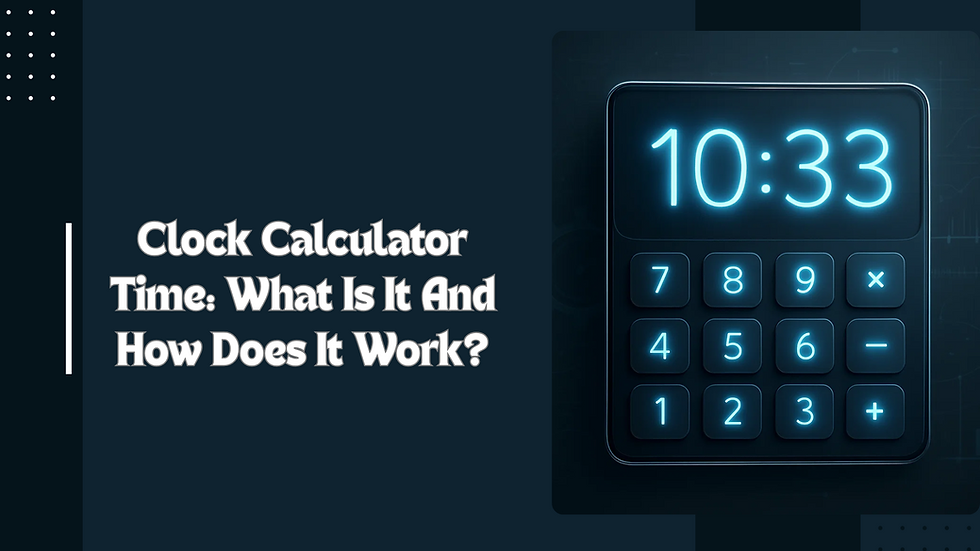Online Timecard: The Smart Solution for Modern Workplaces
- silvalea884
- Jul 31
- 4 min read

Is manual time tracking wasting your hours and costing your business money? Online timecards offer a smarter, more accurate way to log, manage, and review employee work hours — with minimal effort.
Whether you're managing a remote team, a retail floor, or a busy office, digital timekeeping can save hours in admin and ensure your payroll is always on point. Let’s explore how online timecards work, their benefits, and how they compare to traditional tracking methods.
What Is an Online Timecard?
An online timecard is a digital version of the traditional punch card. It allows employees to clock in and out from their computer or mobile device. These entries are stored in the cloud, allowing managers and HR to review, approve, and export work hour data easily.
Key features include:
Clock-in and clock-out buttons
Break tracking
Automatic hour calculations
Real-time reporting
Admin approval workflows
This eliminates the need for manual spreadsheets or handwritten logs — reducing errors and saving time.
How Does an Online Timecard Work?
Online timecard systems operate through secure web portals or mobile apps. Here's a step-by-step breakdown of a typical workflow:
Login: Employee logs into the system.
Clock In/Out: One click to mark start and end of the shift.
Breaks: Optional break buttons to record rest periods.
Dashboard: Managers view, edit, and approve timecards.
Export: Hours are synced to payroll or exported to spreadsheets.
This automation leads to improved efficiency and fewer payroll mistakes.
Benefits of Using Online Timecards
Moving to an online timecard system isn’t just about digitization — it's about making employee time management accurate, efficient, and scalable.
1. Improved Accuracy
Online records reduce the risk of “buddy punching” and human error, offering more reliable data.
2. Faster Payroll Processing
Integration with payroll systems ensures employees are paid correctly and on time.
3. Remote Access
With cloud-based platforms, teams working across different locations can clock in from anywhere.
4. Real-Time Tracking
Managers can monitor attendance trends, flag overtime, and track absences instantly.
5. Legal Compliance
Online systems often include audit trails and comply with labor laws by default — protecting your business during audits.
When Should You Use a Time Card Calculator?
A time card calculator helps businesses total hours worked, including regular and overtime pay. It’s ideal for companies with hourly workers or those who need quick estimations for payroll, especially without an integrated system.
For example, if you're calculating the number of hours an employee worked in a week — including multiple shifts and breaks — a time card calculator simplifies the math and reduces errors.
Later on, as your team grows, you may choose a full-fledged time tracking system with automated calculations.
Can Online Timecards Help Calculate Productivity?
Yes, and here’s how. When time data is collected consistently, it becomes a reliable source for productivity metrics. Managers can calculate productivity by comparing hours worked against project output or deliverables. This helps identify high-performing teams and uncover bottlenecks.
Combined with clear project tracking, online timecards offer insights into:
Time spent per task
Efficiency ratios
Deadlines met or missed
This encourages accountability and gives managers data to optimize workflows.
What Makes a Good Time Tracker for Employees?

A reliable time tracker for employees should be intuitive, flexible, and secure. It needs to support different work styles — remote, hybrid, shift-based — while delivering clear reports and seamless integration with payroll or HR software.
Look for features like:
GPS or IP-based location tracking
Easy punch-in/punch-out
Break and overtime logging
Dashboard views for employees and managers
Mobile app functionality
A time tracker should serve the employee and the employer equally — promoting trust, visibility, and efficiency.
Choosing the Right Online Timecard System
Not every business needs the same features. When selecting an online timecard system, ask yourself:
Do we need mobile support?
What integrations do we require (payroll, HR)?
How many users will need access?
Do we need alerts for overtime or missed punches?
Will our team adopt it easily?
Focus on ease of use, scalability, and data security — these three will set the foundation for long-term success.
You can also watch this video: Emp Monitor | Boost Workplace Productivity with Employee Monitoring Software
Summary
Online timecards have transformed how businesses track and manage employee hours. They eliminate manual processes, improve payroll accuracy, and boost team accountability. Whether you're a startup or a large enterprise, transitioning to digital time tracking is one of the easiest ways to streamline operations.
With tools like a time card calculator and reliable time trackers, you not only track hours but also unlock workforce insights that drive smarter decisions.
FAQs About Online Timecards
Q1: Are online timecards legal?
Yes. In fact, they often improve compliance by maintaining detailed records required by labor laws.
Q2: Can employees clock in from their phones?
Most systems offer mobile apps or browser access, allowing remote workers to log hours easily.
Q3: How much does an online timecard system cost?
Costs vary by provider and features, but many offer scalable pricing for small to large teams.
Q4: What happens if someone forgets to clock out?
Admin can manually adjust the timecard, often with a note or audit trail attached.
Q5: Can I export the data for payroll or reporting?
Yes. Most platforms allow CSV exports or direct integration with payroll software.




Comments